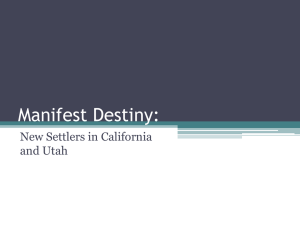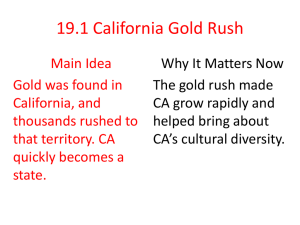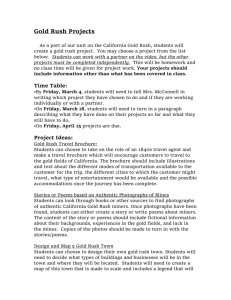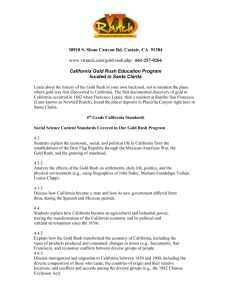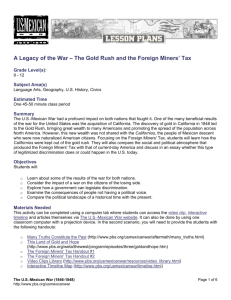On January 24, 1848 James Marshall discovered gold at Sutter`s Mill
advertisement
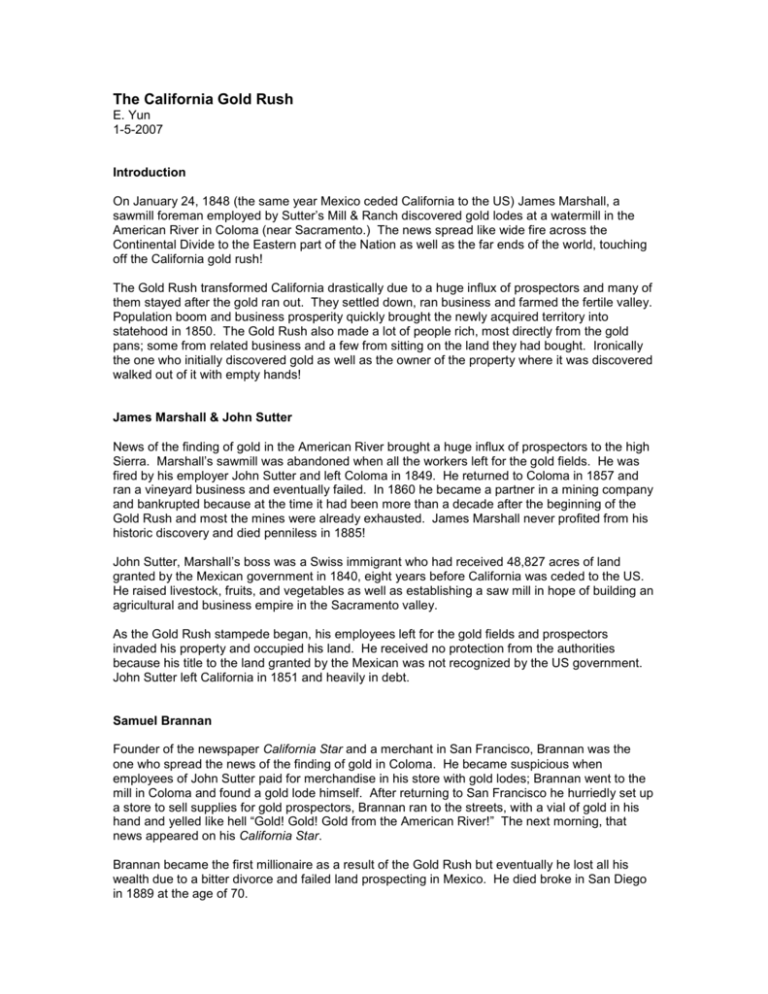
The California Gold Rush E. Yun 1-5-2007 Introduction On January 24, 1848 (the same year Mexico ceded California to the US) James Marshall, a sawmill foreman employed by Sutter’s Mill & Ranch discovered gold lodes at a watermill in the American River in Coloma (near Sacramento.) The news spread like wide fire across the Continental Divide to the Eastern part of the Nation as well as the far ends of the world, touching off the California gold rush! The Gold Rush transformed California drastically due to a huge influx of prospectors and many of them stayed after the gold ran out. They settled down, ran business and farmed the fertile valley. Population boom and business prosperity quickly brought the newly acquired territory into statehood in 1850. The Gold Rush also made a lot of people rich, most directly from the gold pans; some from related business and a few from sitting on the land they had bought. Ironically the one who initially discovered gold as well as the owner of the property where it was discovered walked out of it with empty hands! James Marshall & John Sutter News of the finding of gold in the American River brought a huge influx of prospectors to the high Sierra. Marshall’s sawmill was abandoned when all the workers left for the gold fields. He was fired by his employer John Sutter and left Coloma in 1849. He returned to Coloma in 1857 and ran a vineyard business and eventually failed. In 1860 he became a partner in a mining company and bankrupted because at the time it had been more than a decade after the beginning of the Gold Rush and most the mines were already exhausted. James Marshall never profited from his historic discovery and died penniless in 1885! John Sutter, Marshall’s boss was a Swiss immigrant who had received 48,827 acres of land granted by the Mexican government in 1840, eight years before California was ceded to the US. He raised livestock, fruits, and vegetables as well as establishing a saw mill in hope of building an agricultural and business empire in the Sacramento valley. As the Gold Rush stampede began, his employees left for the gold fields and prospectors invaded his property and occupied his land. He received no protection from the authorities because his title to the land granted by the Mexican was not recognized by the US government. John Sutter left California in 1851 and heavily in debt. Samuel Brannan Founder of the newspaper California Star and a merchant in San Francisco, Brannan was the one who spread the news of the finding of gold in Coloma. He became suspicious when employees of John Sutter paid for merchandise in his store with gold lodes; Brannan went to the mill in Coloma and found a gold lode himself. After returning to San Francisco he hurriedly set up a store to sell supplies for gold prospectors, Brannan ran to the streets, with a vial of gold in his hand and yelled like hell “Gold! Gold! Gold from the American River!” The next morning, that news appeared on his California Star. Brannan became the first millionaire as a result of the Gold Rush but eventually he lost all his wealth due to a bitter divorce and failed land prospecting in Mexico. He died broke in San Diego in 1889 at the age of 70. Levi Strauss and Blue Jean The Gold Rush led to spawn related business; the greatest success story is that of Levi Strauss, a German immigrant who became rich not by striking the "Mother Lode" but by making and selling sturdy clothing to miners. Miners had been frustrated with their fragile clothing; lodes falling out of the holes of pockets and they had long desired to have something more durable to wear. Strauss had tent canvas made into workpants and later used a cotton cloth from France called “serge de Nimes” which became known as denim (丁尼布). Straus improved the durability of the workpants by putting metal rivets at the ends of pockets; the denim pants became popular with miners as well as ranchers and farmers. The work pants became the now popular Levi blue jeans which have evolved into a world-class haute couture (high-end fashion) today! The Chinese Coolies When news of the California Gold Rush reached Canton in 1849, China was plagued by civil war (the Taiping Rebellion,) locust, droughts and floods among other disasters, thousands of “coolies” boarded boats to venture a two-month journey across the Pacific to pursue their dreams of striking it rich in “Gum Shan” as California was known. The Chinese miner population increased steadily from 54 in 1849 to 25,000 in 1863. Since Chinese were not allowed by law to file mining claims, they could only work for mining companies or take over abandoned mines. The Chinese character traits of passion for work, patience, frugality, efficiency, dexterity, and outright perseverance made the coolies prosper from these supposedly “exhausted” placers (gold or mineral deposits.) The success of the Chinese invoked resentment, envy, hostility, and violence against them by the white miners. By 1852, white miners had driven hundreds of Chinese from diggings such as Yuba City and Horseshoe Bar and in 1861 a mob of white miners looted, beat and kicked the Chinese out of the Coloma Chinatown. By 1868, nearly all the placers in the mountains of the Sierra were petered out with gold lodes, some of the Chinese miners returned to their homeland rich, some broke, and the rest were hired by Union Pacific to join ranks with the thousands of newly arrived coolies to build the western section the transcontinental railroad! Charles Crocker, presidents of UP had confidence that the Chinese could lay tracks in the high Sierra because their ancestors could build the Great Wall over mountains and tundra! Up in the high Sierra, there is a beautiful river “Tuolumne” which flows through a small abandoned mining town Chinese Camp. Legend has it that the name was coined by a group of white miners who had trouble finding a proper name for the river; they heard the most commonly used phrase “Tu-La-Ma” from a gang of boisterous Chinese miners gambling by the riverbank, so the white men gladly accepted that for the name of the river for its perceived romantic notion! “Tu-La-Ma” was later corrupted into “Tuolumne!” Gold Rush slide show: http://www.jlhs.nhusd.k12.ca.us/Classes/Social_Science/Gold_Rush/California.Gold.Rush. html

